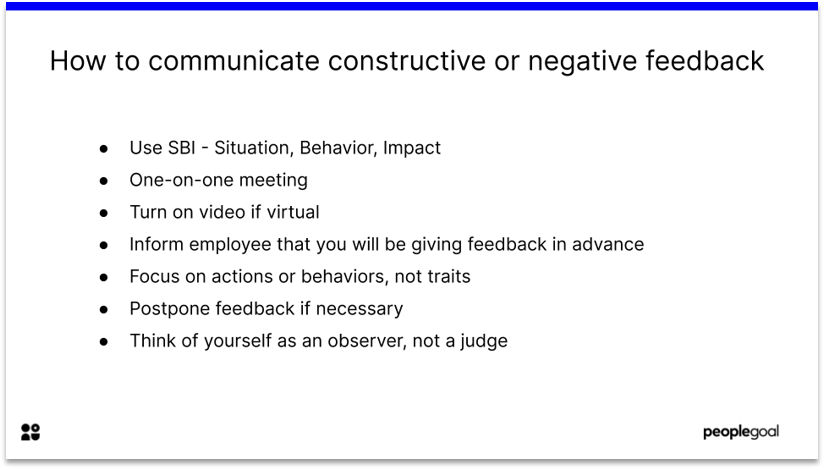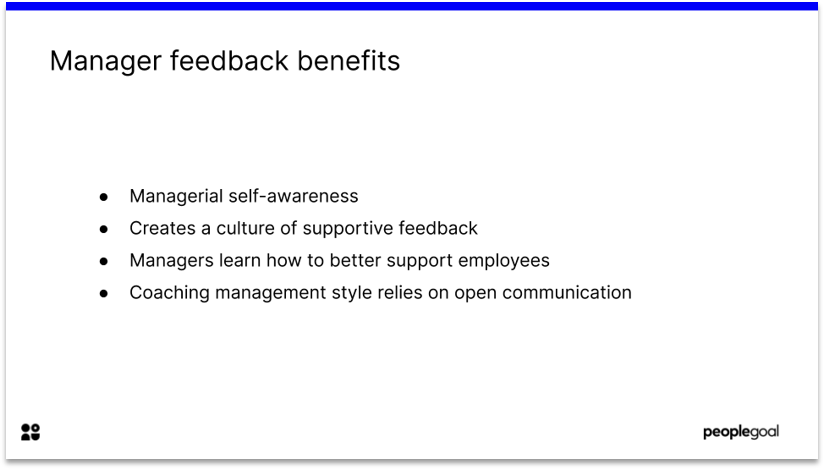Since the pandemic began, many companies have moved to remote work. And it looks like Work-from-home will be with us for the long-run – Slack’s Future Forum Research found that just 12% of employees wanted to return permanently to the office.
How can managers support remote employees? When given effectively, feedback can provide guidance as employees adjust to work from home.
1) Ongoing feedback
Gone are the days when an annual performance review was an employee’s main source of feedback.
The problem with relying on formal reviews overmuch was that providing feedback for the whole year is often less precise and actionable than more regular, informal feedback.
According to Gartner, companies that provide ongoing feedback see performance improve by as much as 12%.
Ongoing feedback recognizes that feedback is not merely a way to praise or scold. Instead, it is part of a collaborative working environment – in which employees offer guidance and pointers to fellow employees. By adopting a coaching management style, managers get involved with the process of ongoing feedback, supported by tools like 360 feedback software.

Benefits of Ongoing feedback
- Improves employee turnover
- Clarifies expectations
- Environment in which feedback is not accusatory or blindsiding – but expected and constructive
- Improves performance and productivity
- Supportive company culture
When we say ‘ongoing’ we don’t mean ‘never-ending’. Try not to over-compromise. Remote workers need support- but they also need space to adjust to new working practices.
You might think of it like writing multiple drafts of a novel. A novelist might seek out pointers and comments once the first draft is written. They may ask questions as they go along. But they also need the time to get the book written!
Employees have different needs – some may feel motivated with more continuous support. The trick is to ask them ‘How much feedback are you looking for?’ and ‘When has my feedback helped you learn?’.
2) Check language and tone
It’s important that managers are conscious of their language and tone when giving feedback.
Feedback, despite our best efforts, is rarely neutral. We may feel frustrated or annoyed at an employee’s behavior. But starting from a place of frustration or upset is likely to make feedback feel overly personal. This will elicit a defensive response.
So how to keep your tone and language professional? You want to avoid employees feeling blindsided by feedback. Perhaps mention your intention to offer feedback in advance- a brief sentence at the start of a one-on-one will usually suffice.
Demotivating words – how to avoid them!
Often when we are disappointed or upset, we fall prey to cognitive distortions.
These can effect the language we choose. For example, saying, ‘Why do you always submit your work late? It makes everyone very stressed’ shows generalization (one of the most common cognitive distortions!)
The employee may not ‘always’ submit work late, and it may have only impacted a few employees. But emotions have run high and made your language inaccurate and demoralizing.
The reality is, when you feel frustrated or on edge, it’s probably not the time to give feedback. Don’t be afraid to postpone feedback until everyone is on a more even keel. You’ll be more likely to constructively criticize employees.
How to keep your language neutral
One way to ensure your language stays neutral is to keep your feedback evidence-based.
Forbes recommends using the SBI Model: __Situation- Behavior-Impact__:
Situation: Describe the situation, when and where it occurred
Behavior: Describe observable behavior. Don’t make judgements or accusations beyond stating actions taken
Impact: What did this behavior make you think/ feel?
Communication can often go awry with remote work, so managers need to make the most out of one-on-ones. Grounding feedback in specific events avoids miscommunication.

3) Make it timely
Ongoing feedback requires managers to identify issues as they arise. Positive feedback reassure employees that they are on the right track.
Consider using software to schedule and record regular one-on-ones.
Tips for keeping feedback timely
- Schedule regular one-on-ones and check-ins
- Consider a daily check-in and offer pointers on projects
- Don’t over-compromise on communication during remote work
4) Make feedback actionable and specific
Feedback needs to be constructive. Whether it’s a minor edit to a presentation, or developing a new skill, we require feedback to improve our work.
By making feedback actionable, we can empower employees to take action on a particular goal.
Create an employee development plan. Have an open, friendly conversation – and set a target for their improvement. This immediately makes feedback forward-thinking.
How to make feedback actionable
- Make the end goal realistic
- Break the goal down into smaller, achievable goals
- Create a personal development plan
- Link goals to upcoming projects
- Follow up in a month’s time
5) Give constructive feedback one-on-one
One-on-one (virtually) is the way to go for constructive feedback! Talking privately makes employees feel less exposed. It also reassures them that managers are willing to take the time to support them.
Where possible, switch on video call. A smiling face and relaxed body language can make feedback less scary. Don’t be afraid to have a sense of humor- with the move to remote work, everyone is facing challenges.
6) Feedback should be a loop!
Great leaders are open to criticism. Courtney Lynch wrote that “Leaders inspire accountability through their ability to accept responsibility before they place blame.”.
Accountability is key. If leaders parcel out negative feedback but do not make themselves accountable – they are likely to create an unhealthy company culture.
So how can managers receive feedback from employees? The most simple way is to ask. During a one-on-one, each time you cite a specific situation, ask the employee, ‘Did I give you enough support during that situation?’.
You can also make use of software to create Weekly Pulse Surveys, as some employees prefer to offer feedback anonymously.
Ways for managers to invite feedback
- Use 360 Feedback for performance reviews
- Hold a virtual town-hall
- Ask for feedback in one-on-ones
- Pulse Surveys

7) Recognize great remote work
Constructive feedback works best in cultures that recognize their employees’ work.
We are much more likely to respond positively to constructive feedback if managers let us know they value our work more widely.
On the other hand, if employees work in environments where they never receive recognition for their work, constructive feedback will seem more disheartening.
Create a culture of recognition. Even if it’s a small win – point out achievements in group meetings. As employees adjust to remote work, this can be incredibly reassuring.
Ways to recognize remote workers
- Food delivery!
- Virtual social event
- Point out great work in daily check-ins
- Send a handwritten note
Give remote workers the feedback they need to thrive
Feedback is a resource. It should be ongoing, so that we can learn from it again and again. Make sure your teams know how they can improve, by setting personal development plans and holding frequent check-ins.
Employees shouldn’t have to face remote work’s challenges alone. PeopleGoal can help you schedule one-on-ones, streamline performance reviews and set SMART targets. Why not book a demo today to find out more?
👉 Alternatively, try our how-to guide to write an effective employee development plan.
Ready to 3x Your Teams' Performance?
Use the best performance management software to align goals, track progress, and boost employee engagement.
